A Study on the Characteristics of High-Solid-Water Filling Materials with Different Water Contents Based on the Boltzmann Superposition Principle
Abstract
:1. Introduction
2. Creep Tests of High-Solid-Water Filling Materials under Different Loading Modes
2.1. Preparation and Basic Physical Properties of High-Solid-Water Filling Materials
2.2. Creep Data Analysis Based on the Boltzmann Superposition Principle
3. The Creep Behavior of High-Solid-Water Materials with Different Water Contents under Graded Loading
3.1. Test Scheme and Results
3.2. Creep Characteristics of High-Solid-Water Materials
3.3. Creep Rate of High-Solid-Water Materials
3.4. The Determination of Long-Term Strength
3.5. The Comparison of Instantaneous and Creep Stress–Strain Curves
4. Conclusions
Author Contributions
Funding
Institutional Review Board Statement
Informed Consent Statement
Data Availability Statement
Conflicts of Interest
References
- Luo, Z.; Li, J.; Wang, L.; Assefa, E.; Deng, H. Study on the Creep Characteristics of Sandstone under Coupled Stress-water Pressure. Period. Polytech. Civ. Eng. 2019, 63, 1038–1051. [Google Scholar] [CrossRef]
- Abouchakraguery, A.; Cormery, F.; Su, K.; Shao, J.; Kondo, D. A micromechanical model for the elasto-viscolastic and damage behavior of a cohesive geomaterial. Phys. Chem. Earth 2008, 33, 416–421. [Google Scholar] [CrossRef]
- Zhou, H.; Jia, Y.; Shao, J.F. A unified elastic-plastic and viscoplastic damage model for quasi-brittle rocks. Int. J. Rock Mech. Min. Sci. 2008, 45, 1237–1251. [Google Scholar] [CrossRef]
- Griggs, D.T. Creep of rocks. J. Geol. 1939, 47, 225–251. [Google Scholar] [CrossRef]
- Ito, H.; Sasajima, S. A thirty-year creep experiment on small rock specimens. Int. J. Rock Mech. Min. Sci. 1987, 24, 113–121. [Google Scholar] [CrossRef]
- Fujii, Y.; Kiyama, T.; Ishijima, Y.; Kodama, J. Circumferential strain behavior during creep tests of brittle rocks. Int. J. Rock Mech. Min. Sci. 1999, 36, 323–337. [Google Scholar] [CrossRef]
- Gasc-Barbier, M.; Chanchole, S.; Berest, P. Creep behavior of Bure clayey rock. Appl. Clay Sci. 2004, 26, 449–458. [Google Scholar] [CrossRef]
- Zhang, Y.P.; Cao, P.; Zhao, Y.L. Visco-Plastic Rheological Properties and a Non-linear Creep Model of Soft Rocks. J. China Univ. Min. Technol. 2009, 38, 34–38. [Google Scholar]
- Shen, W.W.; Yuan, P.B.; Liu, X.W. Study on creep properties of red-bed soft rock under step load. Chin. J. Rock Mech. Eng. 2009, 28, 3076–3081. [Google Scholar]
- Tsai, L.S.; Hsieh, Y.M.; Weng, M.C.; Huang, T.H.; Jeng, F.S. Time-dependent deformation behaviors of weak sandstones. Int. J. Rock Mech. Min. Sci. 2008, 45, 144–154. [Google Scholar] [CrossRef]
- Dubey, R.K.; Gaiola, V.K. Influence of structural anisotropy on creep of rock salt from Slimla Himalaya, India: An experimental approach. J. Struct. Geol. 2008, 30, 710–718. [Google Scholar] [CrossRef]
- Wang, Y.Y.; Wang, Y.C. Numerical simulation of creep law in deep soft rock tunnel under thermal-mechanical-chemical coupling effect. J. China Coal Soc. 2012, 37, 275–279. [Google Scholar]
- Wang, Y.C. Study on the Mechanical Properties of Mudstone Creep and Timeliness of Slope Deformation and Support in Badong Formation. Ph.D. Thesis, China University of Geosciences, Wuhan, China, 2018. [Google Scholar]
- Yang, Q. Creep Mechanical Properties of Artificially Frozen Sandy Mudstone in Western Cretaceous Formation. Master’ s Thesis, Xi’an University of Science and Technology, Xian, China, 2018. [Google Scholar]
- Sun, K.H.; Zhang, R. Experimental Study on the Characteristics of Aeolian Sand Paste-Like Stowing Material in Coal Mine. Adv. Mater. Res. 2014, 962, 1020–1024. [Google Scholar] [CrossRef]
- Qin, G.P.; Wen, Z.J.; Li, A.M.; Zhu, Z.W.; Sun, P.P. Experimental Research and Application of Mining with Paste Material Stowing. Appl. Mech. Mater. 2012, 121, 1416–1420. [Google Scholar] [CrossRef]
- Sun, H.H. Commercial scale trial of a new consolidated backfill technology of full-range tailings with high water content. Non-Ferr. Met. 1993, 45, 7–13. [Google Scholar]
- Wang, X.M.; Guo, J.; Zhang, Q.L.; Peng, X.C. Using high water quick cementing material as packing cementing agent—A study. Met. Mater. Metall. Eng. 1998, 18, 1–4. [Google Scholar]
- Ermolovich, E.A.; Ivannikov, A.L.; Khayrutdinov, M.M.; Kongar-Syuryun, C.B.; Tyulyaeva, Y.S. Creation of a Nanomodified Backfill Based on the Waste from Enrichment of Water-Soluble Ores. Materials 2022, 15, 3689. [Google Scholar] [CrossRef] [PubMed]
- Kongar-Syuryun, C.B.; Faradzhov, V.V.; Tyulyaeva, Y.S.; Khayrutdinov, A.M. Effect of activating treatment of halite flotation waste in backfill mixture preparation. Min. Inf. Anal. Bull. 2021, 2021, 43–57. [Google Scholar] [CrossRef]
- Khayrutdinov, A.; Kongar-Syuryun, C.; Kowalik, T.; Faradzhov, V. Improvement of the backfilling characteristics by activation of halite enrichment waste for non-waste geotechnology. IOP Conf. Ser. Mater. Sci. Eng. 2020, 867, 012018. [Google Scholar] [CrossRef]
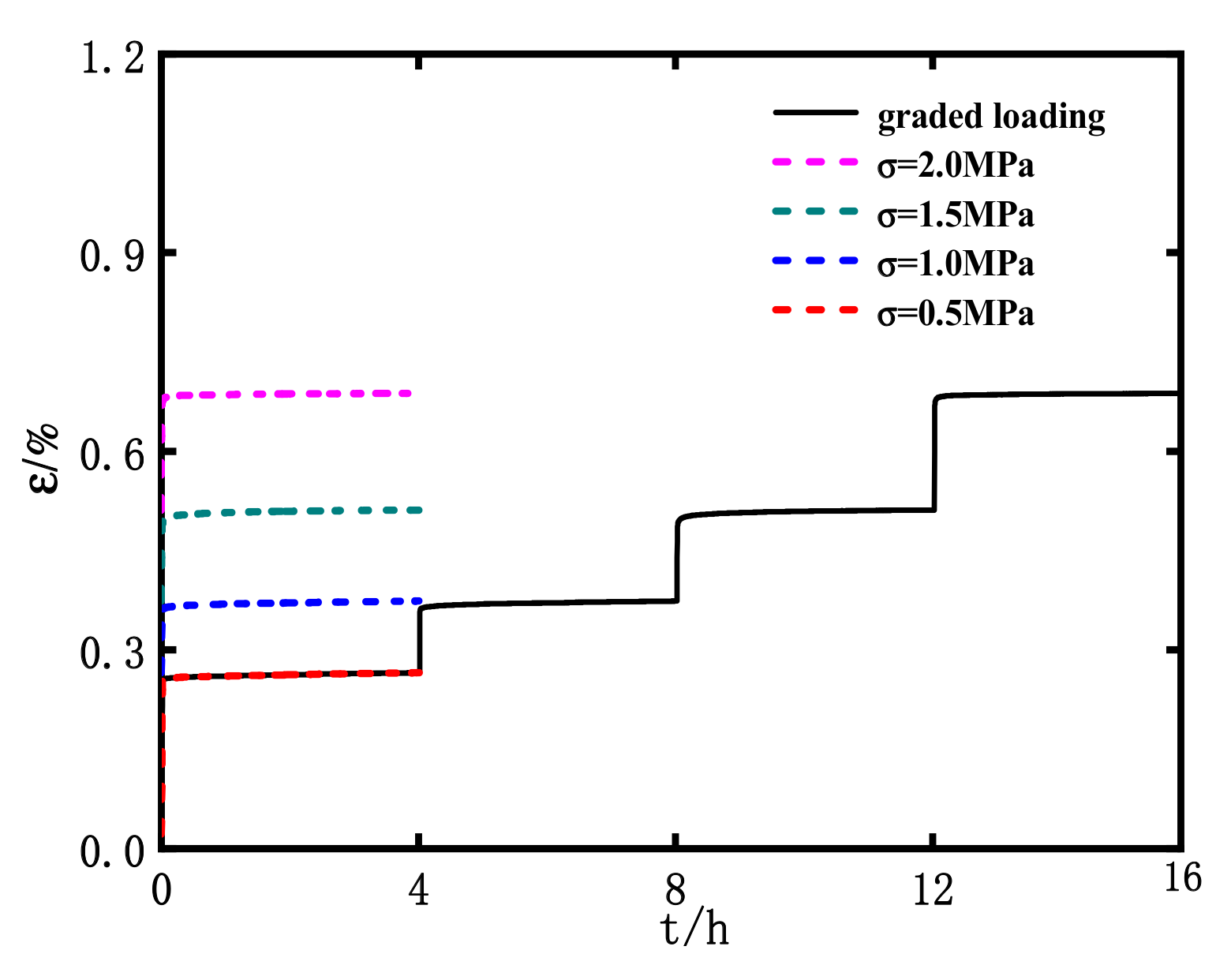

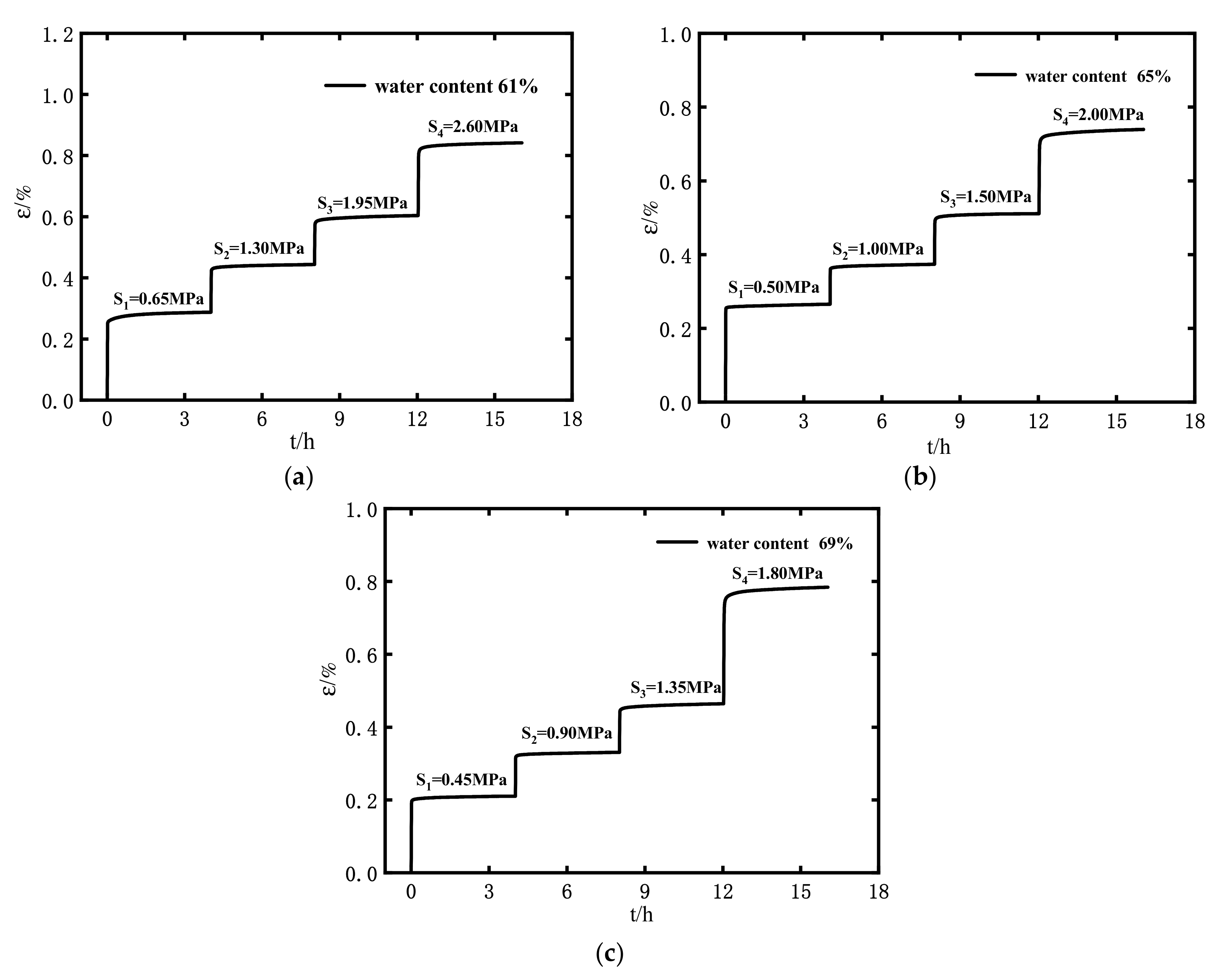
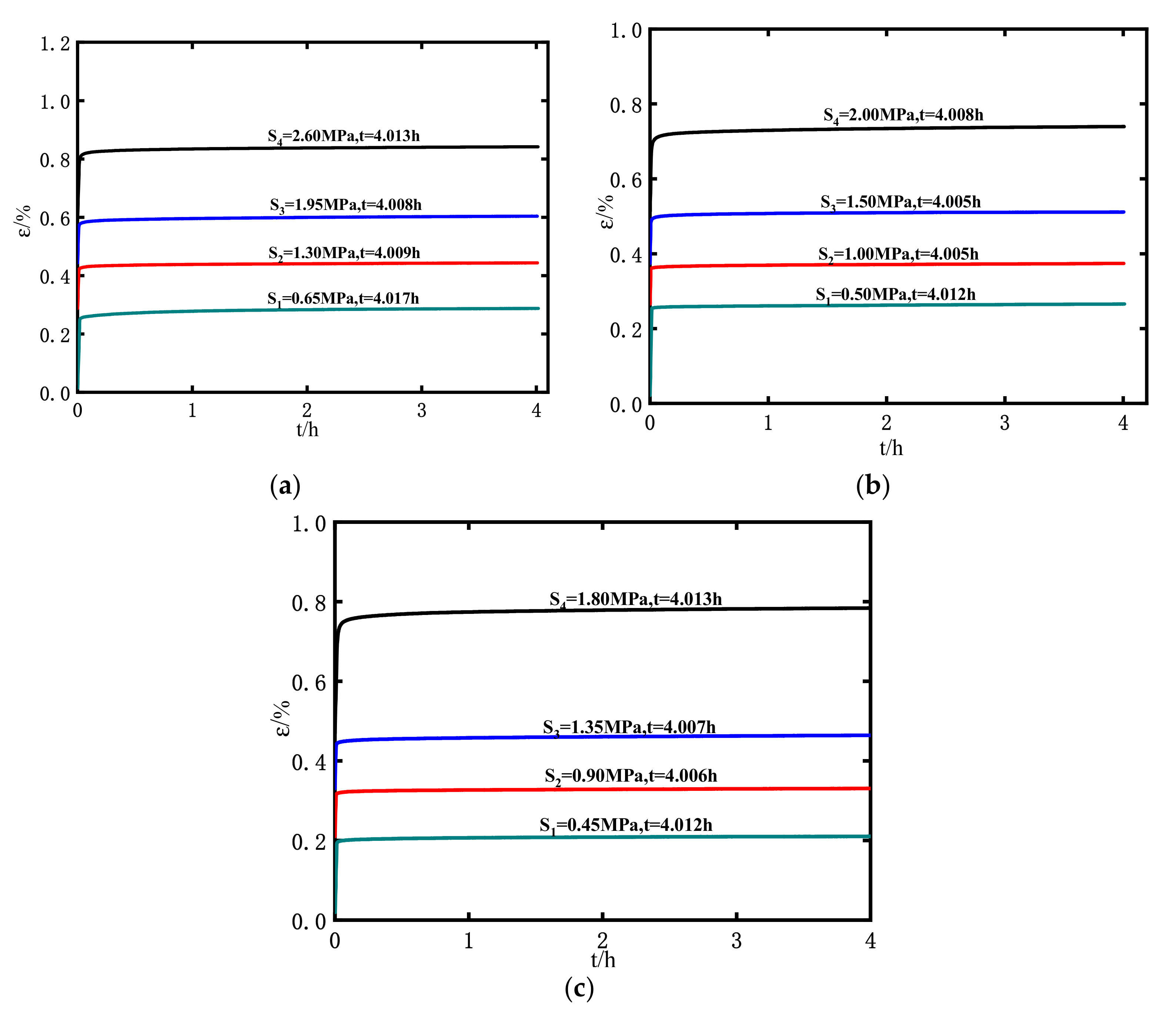
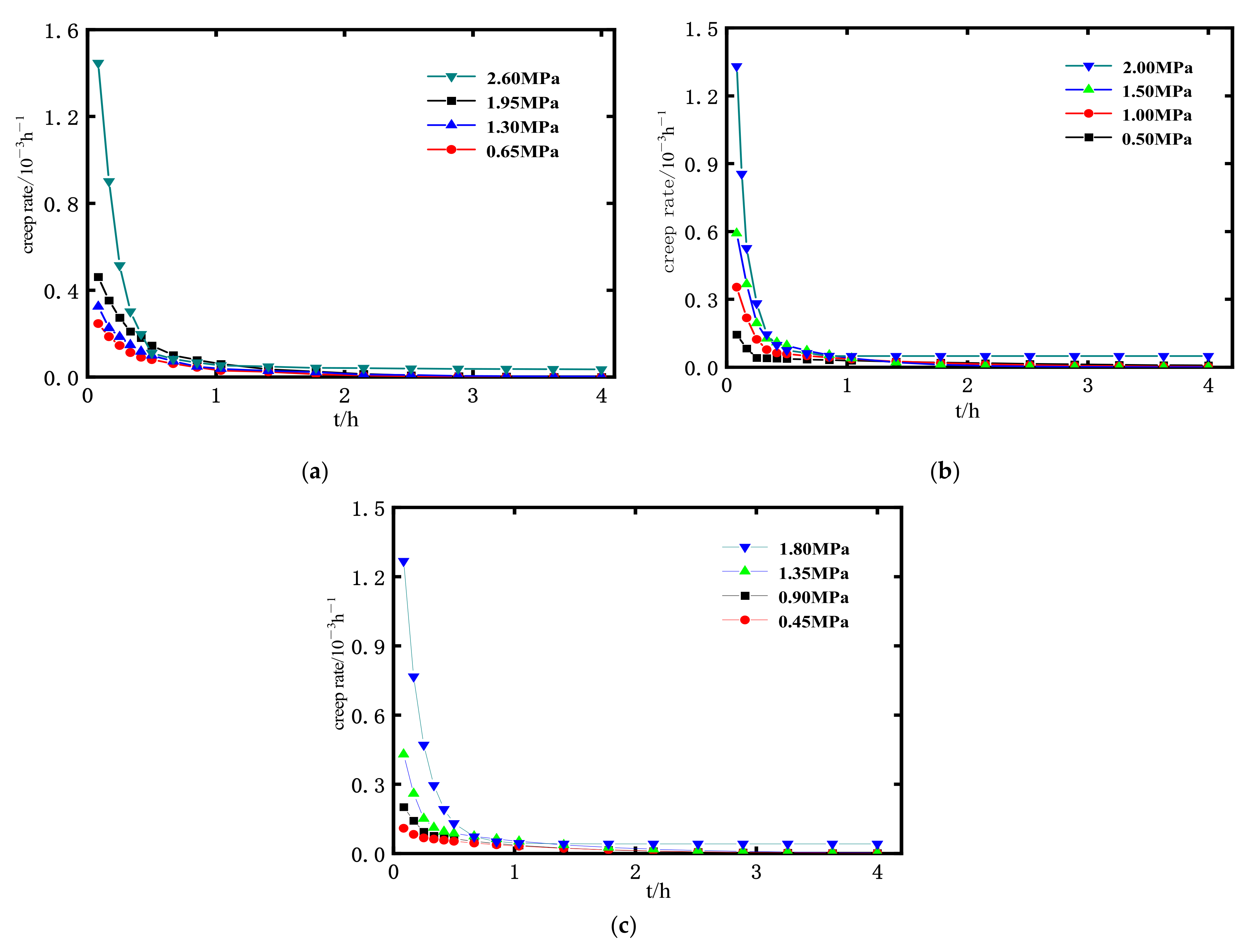
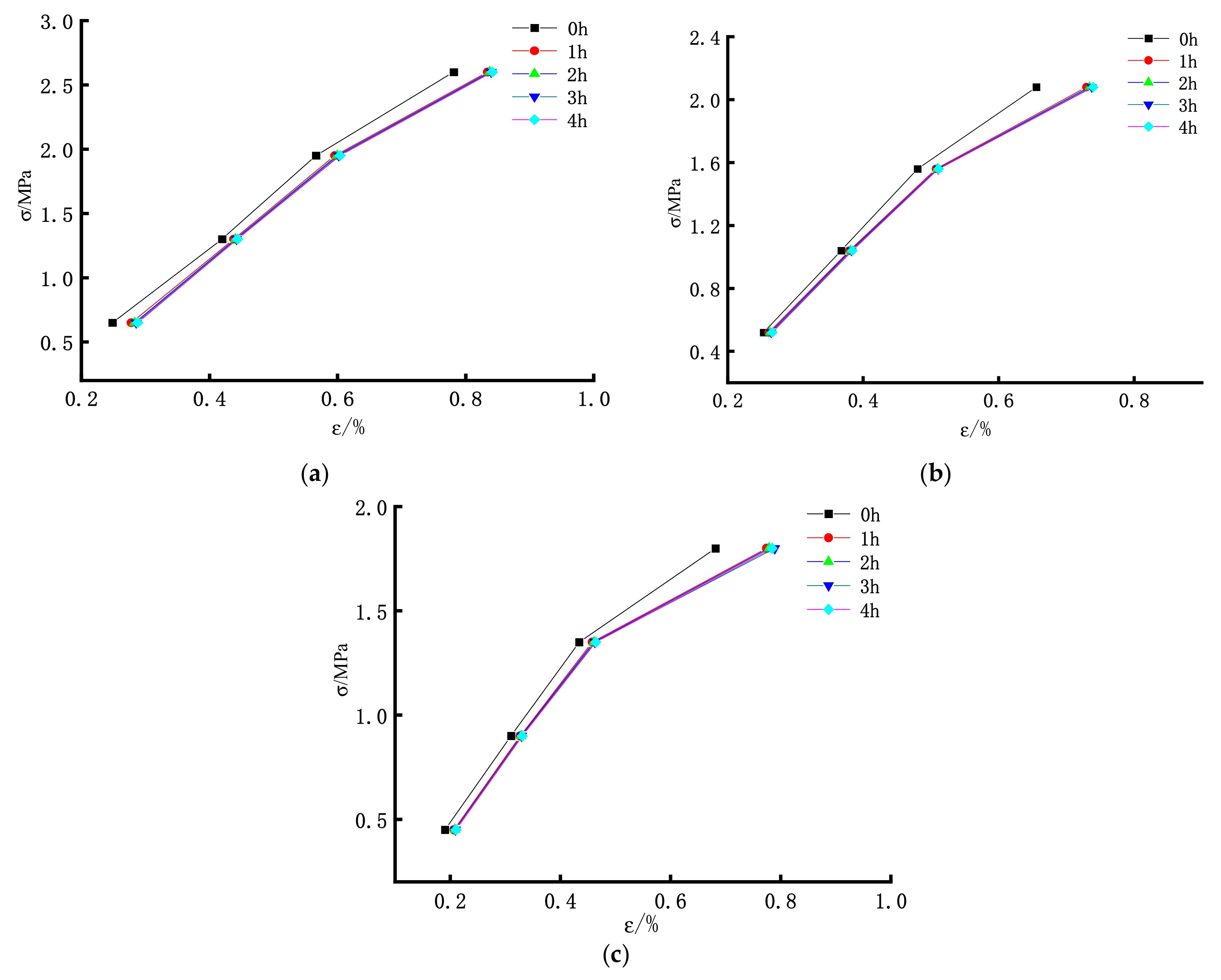
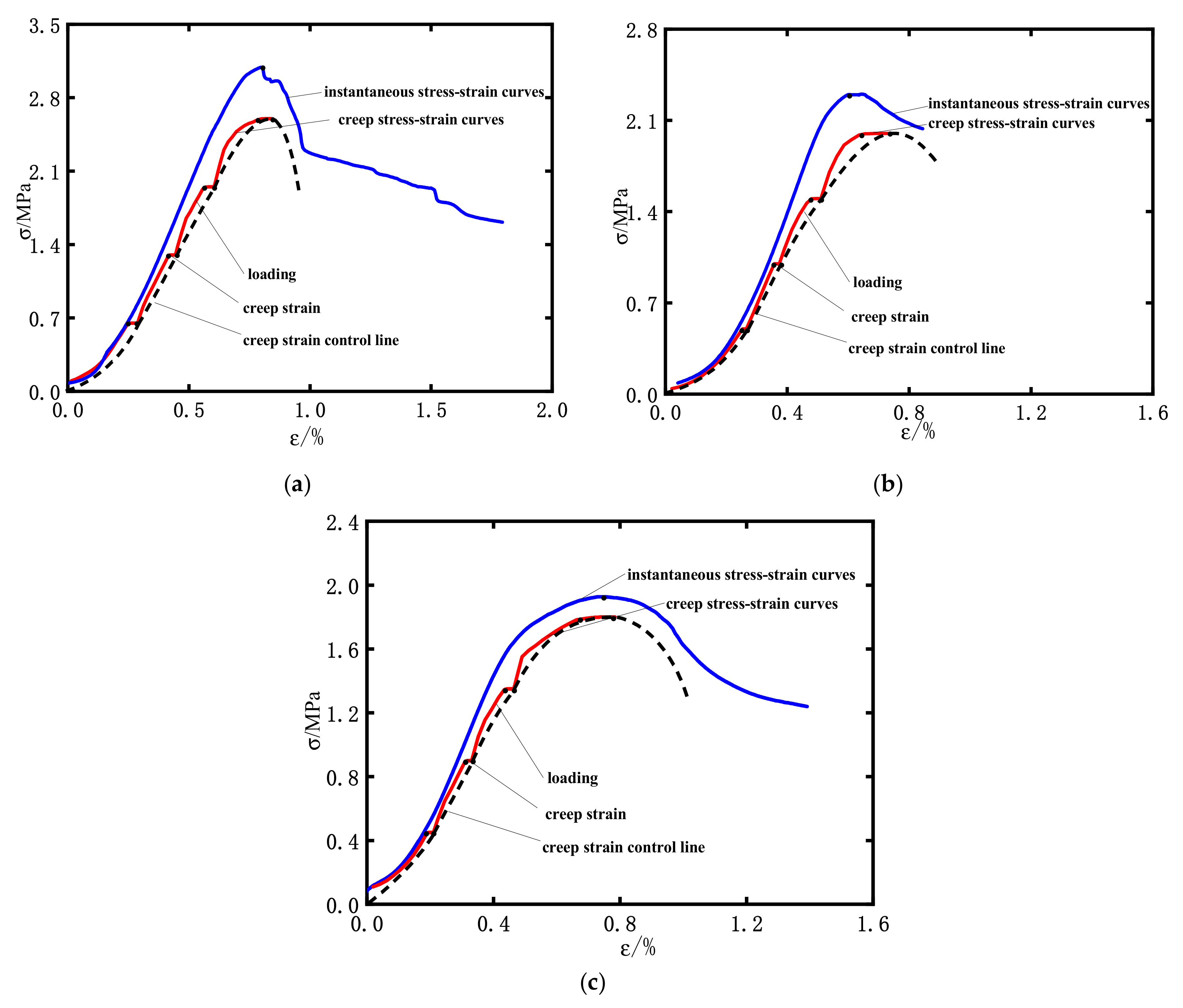
| Chemical Composition | CaO | SO3 | MgO | Al2O3 | SiO2 | P2O5 | Fe2O3 | Loss |
|---|---|---|---|---|---|---|---|---|
| Content (%) | 41.82 | 12.95 | 1.29 | 34.24 | 6.82 | 1.02 | 1.62 | 0.24 |
| Water Content | 61% | 65% | 69% |
|---|---|---|---|
| Setting time | 33 min | 35 min | 39 min |
| Setting time of material A | 12 h | 13.5 h | 16 h |
| Setting time of material B | >24 h | >24 h | >24 h |
| Water Content | Fluidity of Material A/mm | ||||
|---|---|---|---|---|---|
| 2 h | 4 h | 6 h | 8 h | 10 h | |
| 61% | >400 | 385 | 340 | 280 | 210 |
| 65% | >400 | 395 | 380 | 360 | 310 |
| 69% | >400 | >400 | 400 | 385 | 365 |
| Water Content | 8 h | 1 d | 3 d | 5 d | 7 d | 28 d |
|---|---|---|---|---|---|---|
| 61% | 1.99 | 2.36 | 2.58 | 2.64 | 2.73 | 3.05 |
| 65% | 1.45 | 1.79 | 1.99 | 2.09 | 2.12 | 2.32 |
| 69% | 1.08 | 1.40 | 1.57 | 1.70 | 1.78 | 1.93 |
| Water Content | Graded Loading Stress/MPa | |||
|---|---|---|---|---|
| Grade 1 | Grade 2 | Grade 3 | Grade 4 | |
| 61% | 0.65 | 1.30 | 1.95 | 2.60 |
| 65% | 0.50 | 1.00 | 1.50 | 2.00 |
| 69% | 0.45 | 0.90. | 1.35 | 1.80 |
| Water Content | Stress/MPa | Total Strain εt (10−3) | Instantaneous Strain εm (10−3) | Creep Strain εcs (10−3) | Proportion of Instantaneous Strain (%) | Proportion of Creep Strain (%) |
|---|---|---|---|---|---|---|
| 61% | 0.65 | 2.874 | 2.510 | 0.364 | 87.33 | 12.67 |
| 1.30 | 1.565 | 1.344 | 0.221 | 85.88 | 14.12 | |
| 1.95 | 1.600 | 1.289 | 0.311 | 80.56 | 19.44 | |
| 2.60 | 2.379 | 1.872 | 0.507 | 78.69 | 21.31 | |
| 65% | 0.5 | 2.656 | 2.471 | 0.185 | 93.03 | 6.97 |
| 1.0 | 1.084 | 0.954 | 0.130 | 88.01 | 11.99 | |
| 1.5 | 1.373 | 1.151 | 0.222 | 83.83 | 16.17 | |
| 2.0 | 2.281 | 1.812 | 0.470 | 79.44 | 20.60 | |
| 69% | 0.45 | 2.104 | 1.941 | 0.163 | 92.25 | 7.75 |
| 0.90 | 1.205 | 1.040 | 0.165 | 86.31 | 13.69 | |
| 1.35 | 1.334 | 1.099 | 0.235 | 82.83 | 17.17 | |
| 1.80 | 3.199 | 2.356 | 0.843 | 73.65 | 26.35 |
| Water Content | Long-Term Strength σm (MPa) | σm/σ |
|---|---|---|
| 61% | 1.95 | 65% |
| 65% | 1.56 | 67.8% |
| 69% | 1.35 | 69.2% |
Disclaimer/Publisher’s Note: The statements, opinions and data contained in all publications are solely those of the individual author(s) and contributor(s) and not of MDPI and/or the editor(s). MDPI and/or the editor(s) disclaim responsibility for any injury to people or property resulting from any ideas, methods, instructions or products referred to in the content. |
© 2023 by the authors. Licensee MDPI, Basel, Switzerland. This article is an open access article distributed under the terms and conditions of the Creative Commons Attribution (CC BY) license (https://creativecommons.org/licenses/by/4.0/).
Share and Cite
Zhang, J.; Zhou, Y.; Xiao, Y.; Wang, M.; Liu, S.; Yang, Z.; Li, X. A Study on the Characteristics of High-Solid-Water Filling Materials with Different Water Contents Based on the Boltzmann Superposition Principle. Sustainability 2023, 15, 9675. https://doi.org/10.3390/su15129675
Zhang J, Zhou Y, Xiao Y, Wang M, Liu S, Yang Z, Li X. A Study on the Characteristics of High-Solid-Water Filling Materials with Different Water Contents Based on the Boltzmann Superposition Principle. Sustainability. 2023; 15(12):9675. https://doi.org/10.3390/su15129675
Chicago/Turabian StyleZhang, Jianguo, Yuejin Zhou, Yuhang Xiao, Man Wang, Shuaitao Liu, Zhanbiao Yang, and Xiaotong Li. 2023. "A Study on the Characteristics of High-Solid-Water Filling Materials with Different Water Contents Based on the Boltzmann Superposition Principle" Sustainability 15, no. 12: 9675. https://doi.org/10.3390/su15129675
APA StyleZhang, J., Zhou, Y., Xiao, Y., Wang, M., Liu, S., Yang, Z., & Li, X. (2023). A Study on the Characteristics of High-Solid-Water Filling Materials with Different Water Contents Based on the Boltzmann Superposition Principle. Sustainability, 15(12), 9675. https://doi.org/10.3390/su15129675






